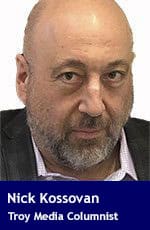Use assertive communication to ace your job interview
 Communication is the king of all skills.
Communication is the king of all skills.
Clear, concise communication is the key to getting and keeping an interviewer’s attention. An hour-long interview boils down to having 30 minutes to make your case.
- First fifteen minutes: Small talk, building rapport, setting the tone for the interview.
- Thirty minutes: Actual interview.
- Last fifteen minutes: Asking questions and wrapping things up, which influences how your interviewer will remember you.
Making your case in 30 minutes requires assertive communication, a powerful skill for conveying your message clearly and directly. When you start using assertive communication, you’ll experience a game-changing shift in your job search and career because it’s linked to self-confidence and an alpha-like personality. These traits are valued in business environments.
 Photo by Natalia Blauth |
| Related Stories |
| Why you should stop outsourcing leadership development
|
| The secret sauce to turning interviews into job offers
|
| The ultimate guide to job interview preparation
|
During the interview process, your competitors will likely exhibit signs of passivity or aggression. In this context, assertive communication is a strategic advantage, making you stand out and, most importantly, be taken seriously. You want to aim for the sweet spot between the timid passivity of “I’m not sure, whatever you think is fine” and the overly aggressive “This is how it’s going to be.”
The assertive communicator strikes a balance between self-promotion and humility. They state their case firmly but also listen to the other person’s point of view. This balance is crucial during an interview, where you must promote yourself by showcasing your qualifications while appearing poised, professional, and easy to work with.
Assertive communication has three elements:
- Adamantly believing in what you speak of.
- Knowing why you believe what you believe.
- Being ready to prove why you believe, think or feel what you do; otherwise, it’s just your opinion, and “opinions” rarely convince anyone to take action.
Here are a few examples of assertive communication in an interview setting:
Scenario 1: Discussing salary expectations
Passive approach: “I’m open to whatever you offer for this role.”
Aggressive approach: “To take this job, I need no less than $80,000.”
Assertive approach: “Based on my 20 years of experience managing inside sales teams and my track record for exceeding sales targets, I think $85,000, plus a commission and quarterly bonus, which we can work out, would be fair. Would this work for you?”
The assertive communicator clearly and confidently states their salary expectations, acknowledges the employer’s perspective, and leaves room for negotiation. Rather than just throwing out a number, they provide context and explanation.
Scenario 2: Addressing a weakness
Passive approach: “I definitely need to improve my public speaking. It’s something I struggle with.”
Aggressive approach: “Public speaking is not my weakness at all. I’m an excellent presenter and communicator.”
Assertive approach: “I’m actively improving my public speaking skills. In my last role, I volunteered to conduct more team presentations. This past March, I joined Toastmasters and have given three talks since. Although I am proud of my progress, there is still room for improvement.”
An assertive communicator acknowledges their weaknesses honestly and explains how they’re addressing them, demonstrating self-awareness and a growth mindset, qualities employers find attractive.
Scenario 3: “Do you have any questions for me?”
Passive approach: “No, you’ve covered everything.”
Aggressive approach: “When can I expect a job offer?”
Assertive approach: “Yes, I do. I’m excited about this opportunity and believe I would excel in this role. How soon can I expect to hear from you regarding next steps? I’m eager to move forward.”
Scenario 4: Expressing interest in the job.
Passive approach: “I’d be happy to work here.”
Aggressive approach: “I am perfect for this job. I expect you to offer it to me today.”
Assertive approach: “This opportunity excites me. Based on our discussion, I can see how my qualifications and experience align with being able to meet the expectations you have for this role; therefore, I’m confident I would excel in this role. I’m very interested in joining your team. Is there anything else I can tell you about my background to help you decide to hire me? Otherwise, when can I expect to hear from you regarding next steps?”
The assertive communicator expresses interest and enthusiasm for the job while respecting the employer’s decision-making process. They state their case compellingly without demanding or pressuring the interviewer.
Today’s job market is hyper-competitive, making job seekers desperate. Hence, it’s becoming common for candidates to ask outright at the end of an interview, “Am I hired?” No matter how much you need or want the job, never ask outright if you got the job.
While it’s understandable you want to “close the deal,” putting pressure on the hiring manager to tell you whether you got the job will create an uncomfortable situation. How you end your interview will influence how you’re remembered. Creating an uncomfortable situation isn’t what you want to be remembered for.
Finding the right balance is the key to assertive communication. Your goal: Be bold and confident without being arrogant or confrontational. Assertive communication is a superpower. Few do it well. It shows employers that you’re self-assured, adaptable, and can advocate for yourself. By embracing aggressive communication, you’ll be far ahead of your competition.
Nick Kossovan, a well-seasoned veteran of the corporate landscape, offers advice on searching for a job.
For interview requests, click here.
The opinions expressed by our columnists and contributors are theirs alone and do not inherently or expressly reflect the views of our publication.
© Troy Media
Troy Media is an editorial content provider to media outlets and its own hosted community news outlets across Canada.

